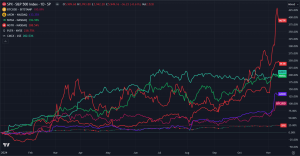When a stock hits 52-week lows, investors usually sit in one of two camps. Either the move lower spooks them out, or they see it as an opportunity to buy at cheaper levels. Granted, there might be valid reasons to support either side of the argument on a case-by-case basis. Yet here are two growth stocks that have struggled recently and I think investors should consider them.
One more for the road
The first idea is Marston’s (LSE:MARS). The pub and brewing company operates 1,468 pubs across the UK, employing around 12,000 people. Over the past year the share price has fallen by 56%, pushing it to 33.5p.
What are the problems? This time last year, the business warned of a continued hit to sales due to lingering Omicron and general Covid-19 issues. As we moved into the summer and beyond, high energy and food costs put further pressure on Marston’s. Finally, the cost-of-living crisis has forced some customers to find cheaper options for food and drink via staying at home.
Inflation does remain a risk going forward, but the other problems, I feel, are fading. Certainly, the presence of Covid-19 is in the rear mirror. The cost-of-living crisis hasn’t gone away, but people have adapted over the past six months.
To this end, a January trading update showed that the growth stock is getting momentum back. Like-for-like sales for the 16 weeks to the middle of January 2023 were up 12.9% versus 2022. Interestingly, for the five key festive days at the end of the year, sales were up 26% versus the 2022 full-year. With sales increasing and costs moderating, profitability should increase for 2023, lifting the share price.
Looking to (the) future
The second stock to consider is Future (LSE:FUTR). The media company owns and operates magazines and sites including Country Life, Go.Compare and Cycling News.
Over the past year, the share price has fallen by 54%, with it trading as low as 1,043p this week. Investors were worried recently regarding the banking exposure the company had to the failed Silicon Valley Bank, even though it was relatively modest.
Further, the departure of CEO Zillah Byng-Thorne after a decade at the helm is seen as a big loss for the business. She has been instrumental in growing Future over the past few years.
It has a relatively simple business model, but one that has been proven to work over many years. It makes money from advertising, affiliates and directly from selling to consumers. For each of the past five years, profit before tax has risen. From £4.4m in 2018, this rose to £170m in 2022.
Based on the strength of the business financially and the continued push to buy brands or grow organically, I’m surprised at how low the share price is. In the long run, I feel this will correct, with a fairer valuation being higher than the current one.
This post was originally published on Motley Fool







